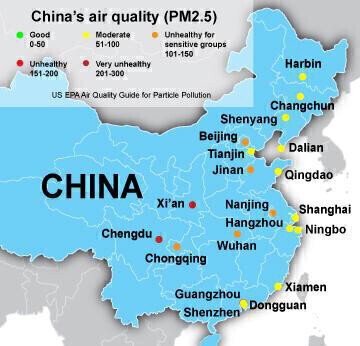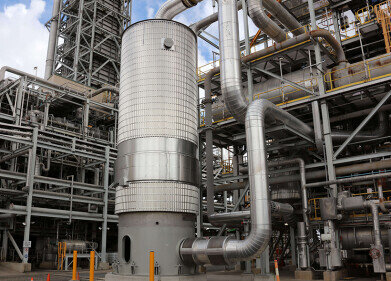Air Clean Up
Regulatory update
Dec 20 2013
Shanghai’s Ministry of Environmental Protection is preparing a series of local soil remediation regulations which is expected to come out by the end of this year, according to Luo Qishi (罗启仕), senior engineer from Shanghai Academy of Environmental Sciences (上海市环境科学院) and one of the drafters of the new regulation. The final draft stipulates municipal and industrial land will require site assessment from a third party and develop remediation plan before it is transferred to other usage of environmental sensitivity, according to Luo .
New regulations issued by China's National Health and Family Planning Commission (NHFPC) at the end of October, which includes mandating research into the effects of air pollution on public health, implicitly recognizes that there is little likelihood of a near-term solution to the country's PM2.5 pollution problems. They also underline the importance for Chinese policymakers to understand what the impact of such pollution has and will be for its citizens. The plan, which is expected to generate demand for specialized foreign-made emissions testing equipment, begins with 16 Chinese provinces and cities where air pollution seriously threatens the environment. These are Beijing, Tianjin, Hebei, Shanxi, Liaoning, Heilongjiang, Shanghai, Jiangsu, Shandong, Henan, Hubei, Guangdong, Chongqing, Sichuan, Guizhou, and Shaanxi .
China Meteorological Administration has drafted and circulated a plan for the country’s meteorological departments to implement the five-year national air pollution control action plan, which proposes a nationwide introduction of human-induced intervention measures in the case of heavy pollution to alleviate smoggy weather by 2015. As planned, in 2015 the meteorological departments will work alongside environmental departments to extend provincial-level and city-level heavy-pollution weather alert system nationwide.
Shanghai launched its first local carbon emission trading scheme on 26 November. Industries covered under the plan includes 191 enterprises from a wide range of industries including iron and steel, chemical, power and airports.
Wuhan has issued an executive plan on improving air quality, aiming to bring down the annual PM10 concentration level by 20% compared to 2012 and the annual PM2.5 concentration level by 20% compared to 2013. By the end of this year, Wuhan will start large-scale supply of vehicle-use diesel oil that lives up to the national IV standard. Meanwhile, the city plans to complete transformation of 755 coal-fired boilers and furnaces located within the city’s Second Ring Road and Third Ring Road, and complete closure and relocation of chemical firms that are currently located within the Third Ring Road, by the end of 2014. In addition, industrial enterprises like Wuhan Iron and Steel, the province’s largest steel maker, will need to complete flue gas desulfurization by the end of 2015.
Beginning 1 July 2014, it will no longer be possible to manufacture a commercial vehicles such as buses unless they are in compliance with the China IV Standard of Limits and Measurement Methods for Exhaust Pollutants from Compression Ignition Engines of Vehicles (NS4). This has resulted in foreign manufacturers of truck engines ramping up their development of new truck engines, and related after-sales servicing and components, which are compliant with NS4, or even NS5, in preparation for what is expected to be a large and growing market.
Trends
Enforcement of regulations seems to be a new area of focus by China’s various levels of government. Publicly announcing major pollution violators is one new tactic the government is trying in order to get companies in compliance with lofty environmental goals. Recent examples of this include:
Tangshan Huifeng Coking Gas Making Co, a Hebei province-based company, was one of many companies found by China's Ministry of Environment Protection (MEP) to be in breach of the legally-mandated emissions standards. The violations were found during a series of inspections carried out in October targeting more of the steel and coking factories that the MEP had found to be problematic polluters in the initial set of industrial inspections it carried out in September.
China’s Hebei Provincial Government has ordered 521 highly-polluting companies to improve pollutant treatment facilities. The report cited Hebei Executive Vice Governor Yang Chongyong, who disclosed the information at a meeting in November. Heavy polluters in the cement, glass, power generation and steel industries have been ordered to take measures to reduce dust, sulfur dioxide and nitrogen oxide emissions by half a million tons beginning in 2015. Additionally, some companies have been ordered to switch their operations from coal to gas power.
Liaoning Province’s Environmental Protection Bureau has fined eight local governments USD 9m (CNY 54m) in a measure to combat air pollution, Xinhua reported. The report cited a statement by the Bureau, noting Shenyang was hardest hit with a USD 6m (CNY 35m) fine.
Beijing plans to strengthen the city’s legislative efforts to fight air pollution by setting limitless fines on repeat pollution violators, and granting citizens the right to seek compensation for pollution-related damages. A similar legislation enforcing recent nationwide regulations against air pollution is being worked on by the central government, and may be released later this year .
Twenty-one enterprises failed to pass the special inspection for air pollution control conducted by the Ministry of Environmental Protection (MEP) in October, according to an announcement of MEP. The inspection covered 65 enterprises in Beijing, Hebei, Shanxi and Inner Mongolia. Of the 21 companies, 14 are from Hebei, while the city of Tangshan, Hebei, alone accounted for seven errant enterprises. At present, Tangshan has imposed administrative penalties on five enterprises, including fines ranging from USD 3,282 (CNY 20,000) to USD 24,615 (CNY 150,000).
Prevention and control of soil pollution has become the latest environmental issue to reach the top of China’s legislative agenda in recent months, following revelations earlier this year that portions of the country’s rice supply was tainted with the toxic heavy metal, cadmium. The country’s Ministry of Environmental Protection (MEP) plans to release a comprehensive action plan on soil pollution soon, the ministry announced on 8 December. The MEP has also set a timeline though 2017 for legislative measures.
Cummins Inc. CEO Norman Thomas Linebarger told shareholders at the Columbus, Indiana-based engines manufacturing company's 3Q13 earnings call that it had raised its guidance for full-year China revenues by 10% compared to 5% previously. And while the increase was driven largely by a 26% rise in industry demand for medium and heavy-duty trucks which the executive attributed to pre-buy ahead of the anticipated implementation of China’s National Standard IV (NS4) emission regulations, he remained far from bullish on near-term growth prospects. Linebarger’s expectation of just a gradual pick-up in demand was attributed to the fact that the Chinese government had yet to provide any “communications” regarding a specific transition plan and timetable for the proposed new NS4 emissions regulations.
In China, future regulations limiting the discharge of contaminants and heavy metals in mining wastewater streams will prove a boon to foreign vendors of mineral and contaminant recovery technology. Today, Chinese mines only adopt mineral recovery technology when it makes financial sense. The central government said recently it plans to spend over USD 480bn (CNY 3tn) to enhance air and water pollution prevention and treatment. It’s likely the government’s moves will spur construction of advanced wastewater treatment and mineral recovery plants at mines in the future.
China is set to further promote use of massive data integration technology of the Internet of Things (IoT) to step up industrial pollution sources monitoring, reported 580114.com, an online telecommunication market intelligence provider. The report cited several remarks from sources who attended a seminar on technologies of environmental-use IoT.
Events
May 23 2024 Beijing, China
May 23 2024 Beijing, China
Jun 10 2024 Algiers, Algeria
Jun 10 2024 Frankfurt, Germany
Singapore International Water Week | Water Expo
Jun 18 2024 Singapore














